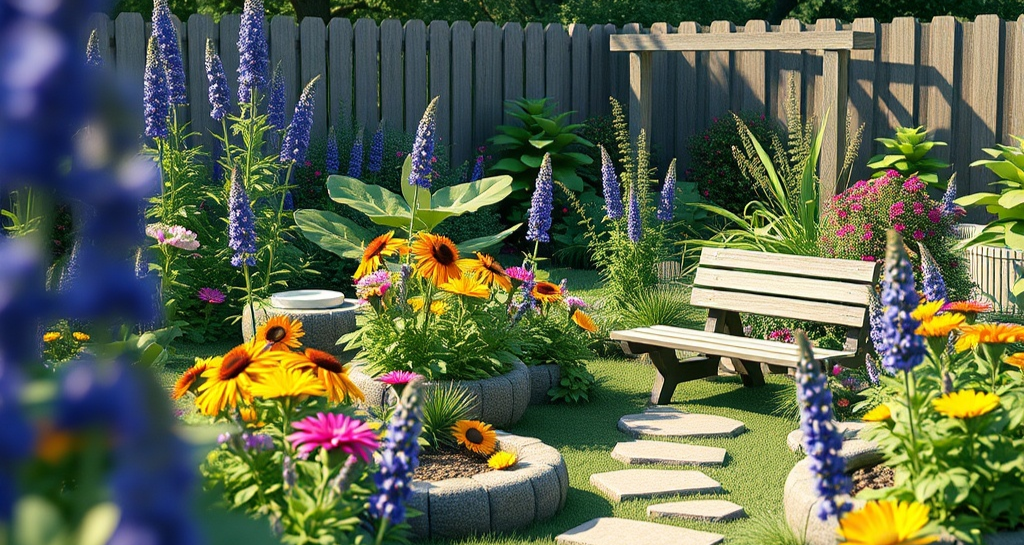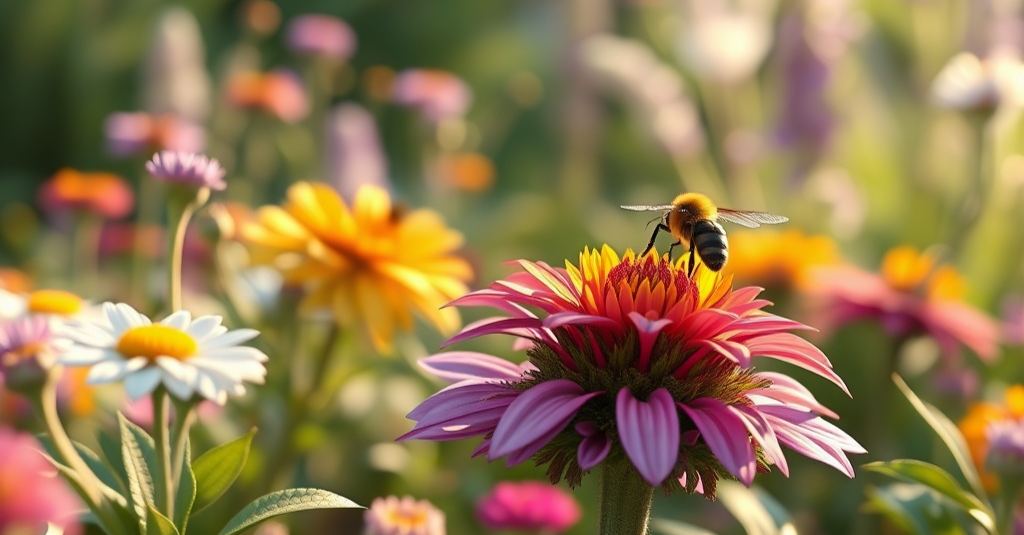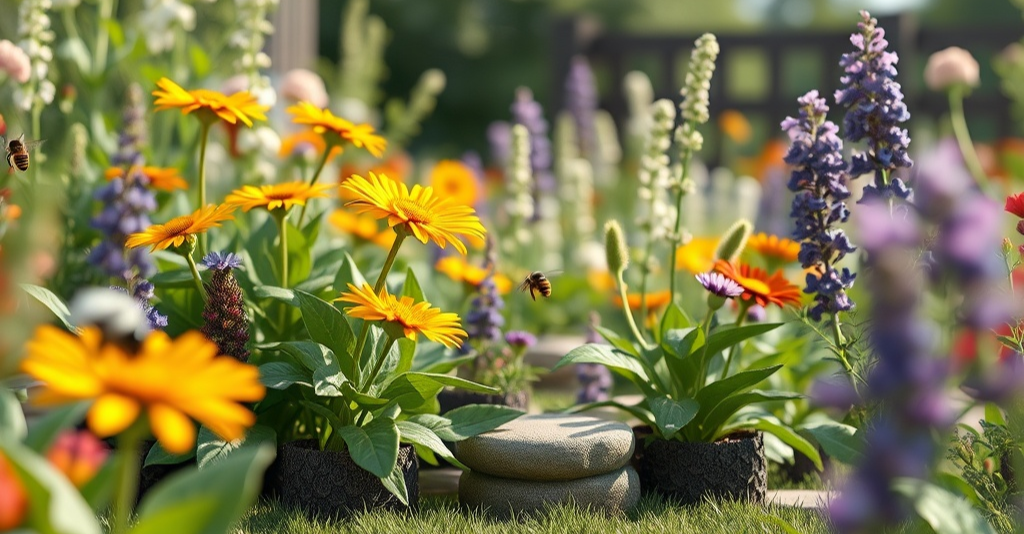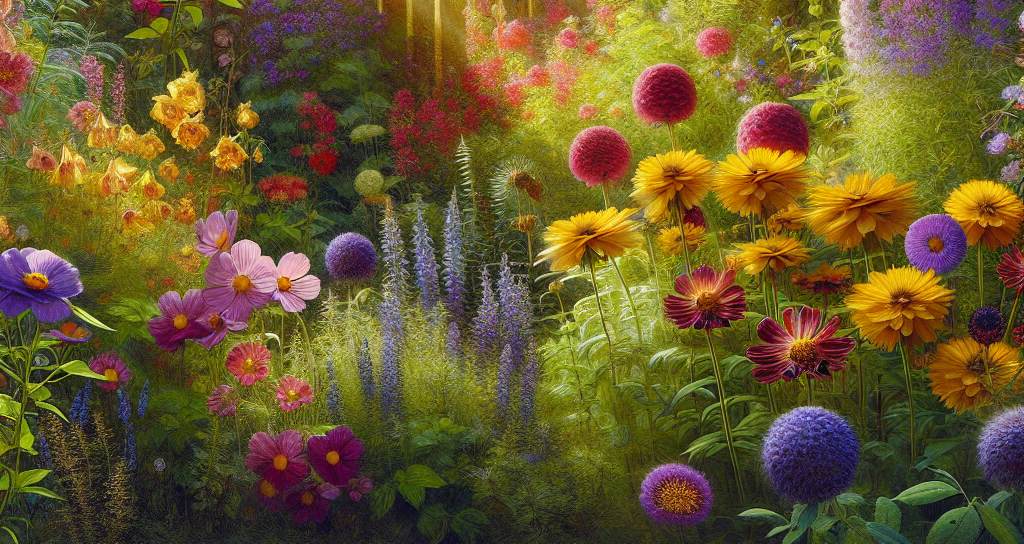Pollinators are critical to sustaining biodiversity and agricultural productivity across the globe. With about 75% of all flowering plants depending on pollinators to reproduce these tiny creatures-such as bees butterflies birds and even bats-play a crucial role in maintaining our ecosystems. Regrettably their numbers are decreasing because of habitat loss pesticide usage and changes in climate.
Transform Your Garden into a Pollinator Paradise is not just a rewarding hobby it is an impactful action you can take to support the environment promote biodiversity and enhance the beauty of your space. This guide will show you how to create a garden that meets the needs of pollinators ensuring their survival while transforming your outdoor space into a lively ecosystem.
Understanding Pollinators and Their Importance
Before diving into the design of your pollinator-friendly garden it is essential to understand why pollinators are so important.
Pollinators facilitate the reproduction of flowering. Plants propagate by moving pollen from one flower to another. This process is essential for the production of fruits. Seeds and even the plants that are necessary for sustaining wildlife and human food systems. Without pollinators many of the crops we rely on-such as fruits vegetables and nuts-would suffer a dramatic decline.
However pollinators are facing increasing challenges that threaten their populations. Habitat destruction overuse of pesticides monoculture farming practices and climate change are all contributing to the drastic reduction in their numbers. You can make a difference by creating a haven for pollinators right in your backyard.
Key Elements of a Pollinator Paradise
There are several fundamental elements to ensure your garden becomes a true haven for pollinators. Let us take a closer look at each component and how it contributes to the health and survival of these essential creatures.
| Key Element | DescriptionExample | Plants |
|---|---|---|
| Native Plants | These are more likely to attract local pollinators and thrive in your local climate. | Milkweed Black-eyed Susan Coneflower |
| Seasonal Blooming | Ensure you have plants that bloom throughout the seasons to provide food year-round. | Crocuses (Spring) Bee Balm (Summer) Goldenrod (Fall) |
| Water Sources | Provide clean and accessible water for pollinators. Shallow birdbaths fountains or small ponds work well. | Birdbath with pebbles for landing |
| Shelter and Nesting | Create safe spaces for pollinators to nest and seek refuge. This could be in the form of bee hotels log piles or undisturbed soil. | Bee hotels dense shrubs log stacks |
| Pesticide-Free | Avoid harmful chemicals. Opt for organic gardening methods and encourage beneficial insects for natural pest control. | Companion planting neem oil |
Step-by-Step Guide to Creating Your Pollinator Garden
Research and Choose Native Plants
The cornerstone of any successful pollinator garden is the inclusion of native plants. Plants native to a certain area have naturally evolved there which makes them well-suited to local conditions. More importantly they have co-evolved with local pollinators providing the right types of nectar pollen and habitat for them to thrive.
Native plants are also more likely to withstand local pests and weather conditions reducing the need for fertilizers and pesticides. This means less maintenance for you and a more sustainable environment for pollinators.
You can find excellent suggestions for regional plants through gardening resources like this pollinator garden guide or by visiting local plant nurseries that specialize in native flora.
Plan for Year-Round Blooming
For your garden to become a true pollinator paradise it is essential to provide food for pollinators throughout the year. Design your garden with a mix of plants that flower at various times of the year. This ensures that pollinators can find nourishment during the lean months when food sources are scarce.
Here is a simple guide to seasonal planting for a pollinator garden:
| Season | Suggested Plants |
|---|---|
| Spring | Crocuses hyacinths violets |
| Summer | Lavender bee balm coneflower |
| Fall | Asters goldenrod sedum |
| Winter | Provide shelter with mulch brush piles and allow some plants to die back naturally |
Install Water Sources
Water is just as essential to pollinators as food. While your garden may seem abundant with flowering plants it is important to remember that pollinators also need access to clean and safe water. Bees for example need water not just for drinking but also for cooling their hives and diluting honey.
To ensure pollinators have access to water:
- Install a shallow birdbath or fountain with stones for pollinators to land on while drinking.
- Keep water fresh by regularly cleaning the birdbath or fountain.
- If space permits you could create a small pond or water garden that serves multiple wildlife species.
Even a basic homemade remedy like using a low container filled with pebbles and water can have a significant impact. For more ideas on water features explore this DIY irrigation guide.
Provide Shelter and Nesting Sites
Pollinators require shelter to protect them from predators and harsh weather as well as suitable places to nest and raise their young. By adding nesting sites you will encourage pollinators to stay in your garden rather than passing through.
- Solitary bees which are non-aggressive will appreciate bare patches of soil where they can burrow. Alternatively you can purchase or build bee hotels to accommodate cavity-nesting bees.
- Butterflies: Create dense patches of shrubs and trees which offer butterflies protection from the elements.
- Birds: Birds are important pollinators too. Planting dense trees and shrubs can provide them with safe nesting sites.
Providing natural shelter is a simple and effective way to make your garden more welcoming to pollinators.
Avoid Harmful Pesticides
Chemical pesticides are one of the leading threats to pollinators. Even those labeled as pollinator-friendly can be harmful if misused. Instead of pesticides consider adopting organic methods such as:
- Companion planting: This involves planting specific plants next to each other to deter pests naturally. For example marigolds can help repel harmful insects that might attack your vegetables.
- Beneficial insects: Introduce natural predators like ladybugs or lacewings that can help control pests without the need for chemicals.
By going pesticide-free you are not only protecting pollinators but also contributing to the health of the overall ecosystem.
Benefits of a Pollinator Garden
Converting your garden into a haven for pollinators provides many advantages both for the ecosystem and your own pleasure.
Enhanced Biodiversity
A diverse array of plants attracts a wide variety of pollinators which in turn helps other wildlife. Birds small mammals and even amphibians may frequent your garden creating a balanced ecosystem.
Healthier Plants and Increased Yields
Pollinators help plants reproduce resulting in healthier more productive plants. This is especially beneficial if you grow fruits and vegetables in your garden. Plants such as tomatoes zucchini and strawberries greatly benefit from bee pollination.
Personal Satisfaction and Connection with Nature
Watching bees buzzing around flowers and butterflies fluttering through the air can be incredibly rewarding. You will gain a deeper appreciation for nature and may find that your garden becomes a peaceful sanctuary for yourself as well.
Common Mistakes to Avoid

Despite the relatively straightforward process of creating a pollinator garden, there are some common pitfalls to avoid:
- Using Harmful Chemicals: Even organic pesticides can be harmful if overused. Opt for mechanical or biological pest control methods where possible.
- Neglecting Water Sources: Pollinators need access to water just as much as food. Ensure there is always a clean water source available.
- Over-Planting Non-Native Species: While non-native plants may look beautiful they often do not provide the necessary nutrients for local pollinators. Prioritize native species that are well-suited to your region.
Supporting Pollinator Conservation Beyond Your Garden
While creating a pollinator paradise in your garden is a great start you can amplify your impact by supporting larger conservation efforts:
- Join Local Conservation Initiatives: Many local groups focus on protecting pollinators through habitat restoration. Joining such initiatives can make a broader impact on the ecosystem.
- Educate Your Community: Share your knowledge with neighbors friends or local gardening clubs. The more people get involved the more we can help pollinator populations rebound.
- Plant More Pollinator Gardens: If you have more space expand your efforts by turning other areas of your property into pollinator-friendly zones. If you live in a community with shared green spaces advocate for pollinator gardens in public parks or common areas.
Examples of Popular Pollinator Plants
Selecting the appropriate plants is crucial for achieving success. Pollinator garden. Native species should be your first choice but there are many plants that are universally appealing to pollinators. Below is a list of some commonly used plants that pollinators love:
| Plant | Pollinators Attracted | Description |
|---|---|---|
| Milkweed | Monarch butterflies bees | Essential for monarch butterfly larvae. Bright clusters of blooms. |
| Bee Balm | Bees butterflies hummingbirds | Vibrant tubular flowers. Thrives in full sun. |
| Lavender | Bees butterflies | Fragrant herb that attracts bees and is drought-tolerant. |
| Coneflower (Echinacea) | Aster Bees butterflies | Blooms in late summer to fall providing food when other flowers fade. |
| Sunflowers | Bees butterflies birds | Large sunny blooms provide food for pollinators and birds. |
| Zinnias | Butterflies bees | Bright colorful flowers that are easy to grow from seed. |
| Goldenrod | Bees butterflies beneficial insects | Provides late-season nectar thrives in various conditions. |
| Black-eyed | Susan Bees butterflies | Hardy perennial with bright yellow petals. |
Advanced Pollinator Garden Design Tips

Once you have mastered the basics of creating a pollinator paradise you can elevate your garden by incorporating more advanced design techniques. Here are some additional strategies to further enrich your space:
Cluster Your Plantings
Pollinators especially bees are more likely to visit gardens with clusters of the same type of plant rather than single scattered blooms. By grouping flowers of the same species together in clusters you make it easier for pollinators to find food and you enhance the visual impact of your garden.
Incorporate Vertical Layers
Think of your garden as a layered ecosystem with different heights of plants attracting different types of pollinators. Tall sunflowers for example will appeal to birds and larger pollinators while lower-growing flowers like lavender or creeping thyme can provide food for ground-dwelling insects Consider adding trellises or vertical planters to maximize space and provide more feeding opportunities.
Add Companion Planting
Planting companionably involves growing specific plants together because they mutually benefit each other. In a pollinator garden this can help deter pests naturally and improve the health of your plants. For example marigolds planted among vegetables help to repel harmful insects while herbs like basil and thyme attract beneficial pollinators and ward off pests.
For a deeper dive into advanced irrigation techniques and how to keep your pollinator garden thriving check out this helpful DIY irrigation guide.
Design with Diversity in Mind
It is important to have lots of different types of plants in your garden. This helps make sure that there is always enough food for different kinds of bees butterflies and other helpful insects. Having a variety of plants also makes it harder for pests and diseases to cause problems. When choosing plants try to pick ones with different kinds of flowers. Some insects like big open flowers while others prefer long tube-shaped ones.
Role of Urban Gardens in Pollinator Conservation
Urban environments present unique challenges for pollinators such as a lack of green spaces increased pollution and heavy pesticide use. However urban gardens have tremendous potential to support pollinator populations by providing mini-habitats amidst the concrete jungle. If you live in a city or an area with limited outdoor space you can still make a big difference by cultivating a pollinator-friendly balcony rooftop garden or community plot.
Here is how to make the most of a small space:
- Container Gardening: You can create a lovely space for bees and butterflies on even a small balcony or patio. Just use pots window boxes or hanging baskets to grow pretty flowers that will attract these helpful insects.
- Green Roofs: If you have access to a flat roof consider installing a green roof planted with pollinator-friendly species. This can be an excellent way to provide a refuge for pollinators in densely populated areas.
- Vertical Gardens: Short on space? Vertical gardening is an awesome way to grow plants! even if you do not have much room. Many pollinator-friendly species such as climbing vines thrive in vertical gardens.
Urban gardens are not only beneficial for pollinators but can also enhance community well-being by providing green spaces that promote relaxation biodiversity and beauty. Explore more urban garden planning tips in this seasonal planning guide.
The Impact of Pollinator Gardens on Climate Change

Pollinator gardens help more than just the bees and butterflies they also help fight climate change. Gardens with lots of different plants can trap carbon cool down cities and save water. Also by growing plants that are local to your area you can spend less time and money on watering fertilizing and using chemicals.
How Pollinator Gardens Support Climate Resilience
- Carbon Sequestration: Plants absorb carbon dioxide which is a significant greenhouse gas through the process of photosynthesis. Native plants especially trees and shrubs can absorb more carbon than traditional lawns.
- Water Conservation: Pollinator gardens that are designed with native drought-tolerant plants require less water than non-native lawns or ornamental flowerbeds. This reduces the strain on local water supplies particularly in areas prone to drought.
- Soil Health: Healthy well-vegetated gardens improve soil structure reduce erosion and enhance the soils ability to absorb and store water helping to prevent flooding and reduce water runoff.
By creating a pollinator paradise you are not only supporting biodiversity but also contributing to a more sustainable and climate-resilient landscape. For more information on creating eco-friendly gardens visit this pollinator paradise guide.
Why are pollinators important for my garden?
Pollinators are essential for the reproductive processes ofnumerous. By transferring pollen from one flower to another they facilitate fertilization leading to the production of seeds and fruit. A garden with active pollinators can yield better harvests and more vibrant plant life.
What are some common pollinators?
Several of the most frequent pollinators are bees, butterflies and moths hummingbirds and certain species of bats and beetles. Each pollinator is attracted to different types of plants so having a varied garden can support a wide range of pollinator species.
I have a small urban garden can I still support pollinators?
Absolutely Even a small urban garden can make a big difference for pollinators. Every little patch of greenery helps provide resources for pollinators navigating urban environments.
Are there any pollinators that can hurt plants in my garden?
While pollinators generally play a beneficial role in gardens some insects such as certain beetles might feed on flowers or plants as they pollinate. Most pollinators however will not harm your plants and contribute to a thriving garden ecosystem. Focus on creating a balanced environment where beneficial insects can manage potential pests naturally.
What are the best plants to attract pollinators?
Opting for native plants is the most effective way to lure local pollinators. For instance milkweed coneflower bee balm lavender and sunflowers are great examples. These plants offer nectar and pollen for various pollinators like bees butterflies and birds.
